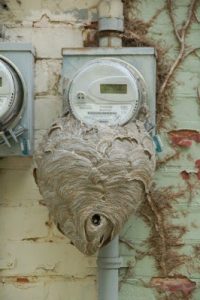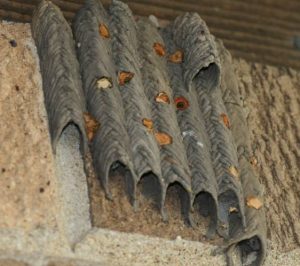You might live in a row house, an apartment house, a single-family dwelling. You might have a carport or outbuildings. You might be buttoning up a concession stand for the winter and moving the picnic benches under cover for the winter.
And then … you see it. Feel it. A wasp or hornet nest, up in the corner of a window jamb or down under a bench. It might even be in a porch light fixture or a parking meter. It might feel like dried mud. Vaguely resemble a chunk of honeycomb, minus the honey. Look like a football (more or less), built of layer upon layer of flaky gray papery stuff.

You don’t see any wasps flying in or out. But just to be sure, you get the wasp spray and douse that nest but good. And hope you killed them all, because the last thing you want is wasps knocking at the door this year or next.
But… nobody’s home. It’s not summer anymore. The old queen has died. A newly fertilized queen, replete with eggs, is doing the insect equivalent of hibernation and taken refuge beneath a piece of bark somewhere.
And the rest of the hive? Each member has died a solitary death. Not one is holed up in the nest, waiting to help the new queen clean house, make necessary repairs, and set up shop come spring. Even knowing this, maybe you’re inspired to knock down the hive and stomp on it, just to be sure. Besides, you don’t want wasps nesting under the picnic benches ever again.
Knocking the nest down is all well and good, but it’s rare that a queen would repopulate it anyway. She wants a fresh start. If come spring you see the occasional wasp hanging out on an old hive, know that it’s gathering material for new digs somewhere else. If you’re a paper wasp, for instance, it’s easier to chew that old nest into a mushy pulp for brand new paper than to strip wood from a twig and start from scratch.

Yes, it’s lucky no one handled that nest under the picnic bench or fire-escape railing or any of a hundred other places that nest might have been.
But should you see some wasps next spring and suddenly this story comes to mind, take a look around you. See any signs of tiny new nests taking shape? Are they high under an eave and far from anyplace you could get to with ease? Or is one right next to the entryway to your home? We’ll have a brand-new post for you with brand-new info on wasps, their nests, and what to do about them.
Can’t wait? Go here.